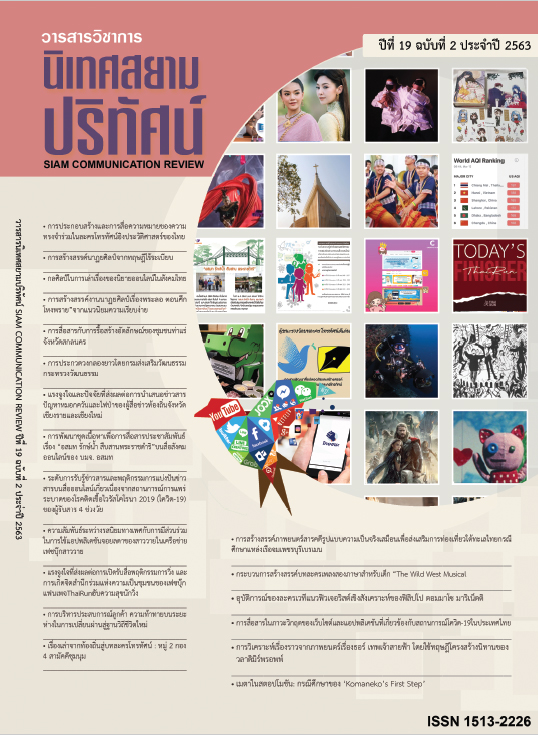News Perception Level and News Perception Behavior on Social Media about Coronavirus Disease 2019 (Covid-19) in 4 Generations
Main Article Content
Abstract
The research “The Level of News Literacy and News Sharing Behavior on Social Media about Covid Disease-19 in 4 Generations” aims tostudy (1) The level of news perception on social media about Coronavirus Disease 2019 (COVID-19) in 4 generations (2) The news sharing behavior on social media about Coronavirus Disease 2019 (COVID-19) in 4 generations with 400 onlinesampling questionnaires.
The study shows that level of news perception in 4 generations receivers. (1) Thelevel of news access is at a high ( X= 3.80) and (2) ) The level of news estimate is at a high ( X= 3.67) For news analysis rules in 4 generations receivers isreliability news source and they will compare the news information from various channelsvarious news agencies. In addition, generation Y and generation Z receivers give moreimportance to the movement on online media: number of news page followers andaddiction society etc.
For news sharing factors n 4 generations receivers. Because situation of Coronavirus Disease 2019 (COVID-19) causing the receivers keep up with the news to keep up to date with thespread of the disease. The most, they share proximity news. The second, they share consequencenews and progress news.
Article Details
References
นันทิกา หนูสม และวิโรจน์ สุทธิสีมา (2562). ลักษณะของข่าวปลอมในประเทศไทยและระดับความรู้เท่าทันข่าวปลอมบนเฟซบุ๊กของผู้รับสารในเขตกรุงเทพมหานคร. วารสารนิเทศศาสตร์ 37:1.
บรรยงค์ โตจินดา. (2543).การบริหารงานบุคคล. กรุงเทพฯ: รวมสาส์น.
ปรมะ สตะเวทิน. (2546). หลักนิเทศศาสตร์. กรุงเทพฯ: รุ่งเรืองสาส์นการพิมพ์
ประกิจ อาษา และสุธาวัลย์ ธรรมสังวาลย์ (2563). หลักการวิเคราะห์ข่าวสารและหลักเกณฑ์การแบ่งปันข่าวสารบนสื่อสังคมออนไลน์ของคนกรุงเทพมหานคร. วารสารนิเทศสยามปริทัศน์ 1 : ประจำปี 2563, 144-159
ประยงค์ มีใจซื่อ. (2542). พฤติกรรมองค์กร (พิมพ์ครั้งที่ 2). กรุงเทพฯ: สำนักพิมพ์ฅมหาวิทยาลัยรามคำแหง.
ภาคภูมิ หรรษา. (2554). การเขียนข่าวเบื้องต้น. กรุงเทพฯ: อินทนิล, สนพ.
ศิริชัย ศิริกายะ.(2557). แบบจำลองการสื่อสารในยุคดิจิทัล. วารสารนิเทศสยามปริทัศน์ 15: 8-13.
ศูนย์การศึกษาและฝึกอบรมด้านสารสารศาสตร์. (2563). การนำ เสนอข่าว ข่าวลวง และข้อมูลบิดเบือน. กรุงเทฑฯ: สำนักพิมพ์บุ๊คสเคป
สุปัญญา ไชยชาญ. (2543). หลักการตลาด (พิมพ์ครั้งที่ 2). กรุงเทพฯ : พี.เอ.ลิฟวิ่ง.
ภาษาอังกฤษ
Anthony Adornnato. (2018). Mobile and Social Media Journalism. SAGE Publishing.
Bruce D.Itule and Douglas A.Anderson. (2007) News Writing & Reporting For Today’s Media. McGraw-Hill Higher Education
ระบบออนไลน์
อุษา บิ้กกิ้นส์. (2555). การรู้เท่าทันสื่อและสารสนเทศ.วารสารสุทธิปริทัศน์, 26, 147-161. เข้าถึงได้จาก https://www.dpu.ac.th/dpurc/assets/uploads/magazine/
m37aw9rqdkgowcow08.


